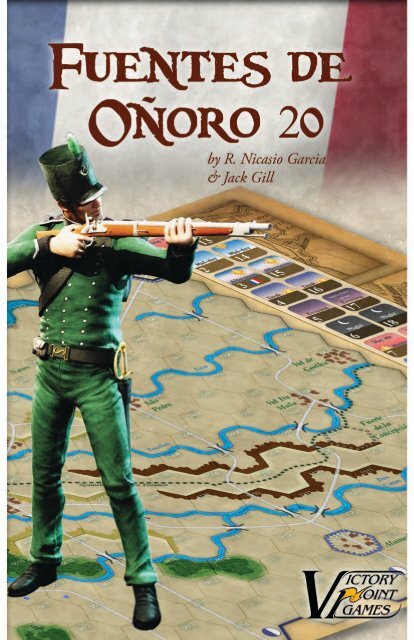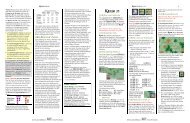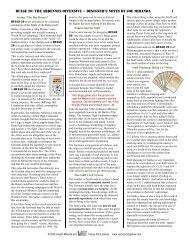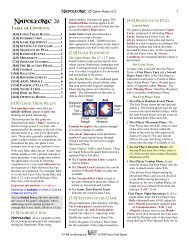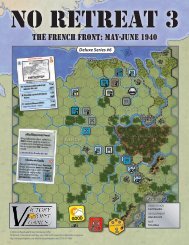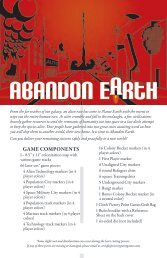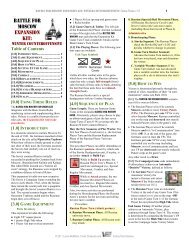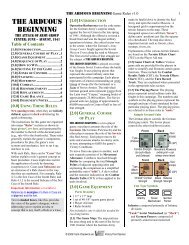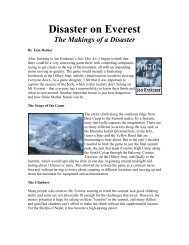Rules booklet - Victory Point Games
Rules booklet - Victory Point Games
Rules booklet - Victory Point Games
- No tags were found...
You also want an ePaper? Increase the reach of your titles
YUMPU automatically turns print PDFs into web optimized ePapers that Google loves.
Napoleonic 20 Standard Game <strong>Rules</strong> v3.0 1Napoleonic 20Standard Game rulesTABLE OF CONTENTS[1.0] INTRODUCTION ............................ 1[2.0] GAME EQUIPMENT....................... 1[3.0] SETTING UP THE GAME ................ 2[4.0] SEQUENCE OF PLAY ..................... 2[5.0] RANDOM EVENTS ......................... 3[6.0] MOVEMENT .................................. 3[7.0] ZONES OF CONTROL .................... 4[8.0] THE REACTION PHASE ................ 5[9.0] COMBAT ....................................... 6[10.0] RALLYING ................................. 12[11.0] REINFORCEMENTS .................... 13[12.0] ARMY MORALE ........................ 13[13.0] PASSING (“LULLS”) .................. 14[14.0] NIGHT TURNS ........................... 15[15.0] HOW TO WIN ............................ 15[16.0] OPTIONAL RULES ..................... 15EXCLUSIVE RULES ................... 22[0.0] USING THESE RULESNew gaming terms, when initially defined,appear in dark red lettering for quickreferencing.The instructions for this game are organizedinto major “<strong>Rules</strong>” sections as shown in largegreen CAPS font, and represented by thenumber to the left of the decimal point (e.g.,Rule 4.0 is the fourth Rule). These <strong>Rules</strong>generally explain the game’s subject matter,its components, the procedures for play, thegame’s core systems, how to set it up, andhow to win.With each Rule, there can be “Cases” thatfurther explain a Rule’s general concept orbasic procedure. Cases might also restrict theapplication of a Rule by denoting exceptionsto it. Cases (and Subcases) are an extensionof a Rule shown in the way that they arenumbered. For example, Rule 4.1 is the firstCase of the fourth Rule; and Rule 4.1.2 is thesecond Subcase of the first Case of the fourthRule.Important information is in red text.References to examples of a Rule or Case are inblue text and this font.Text in shaded boxes, like this, provides thevoice of the game’s designer, who isaddressing you to explain an idea or conceptthat is not, itself, a Rule or a Case.[1.0] INTRODUCTIONNapoleonic 20 is a wargame system forrecreating operational level campaigns duringthe Napoleonic Wars using about 20 pieces(often less) per side per game. This Standard<strong>Rules</strong> section applies to all games in theseries, each of which also has its ownExclusive <strong>Rules</strong> section at the end.Game Scale: Each unit represents a divisionto a corps of troops (roughly 8,000 to 20,000men and their equipment). Each space on themap is approximately one-half to one mileacross.[2.0] GAME EQUIPMENTThe Game Map: The game board featuresa map portraying the area where that battleor campaign took place. Superimposedover it is a hexagonal grid that regularizesthe pieces’ movement and positioning.The Playing Pieces: The cardboard gamepieces* represent the actual military unitsthat participated in the campaign. Theseplaying pieces are called ‘units’ and theinformation on each is read as shown:Designation(2nd Corps)Type(Infantry)FrontCombatStrengthMovementAllowanceBackHiddenUnit(French)Combat Strength is the value of that unitwhen engaging in combat.Movement Allowance is the speed andendurance of that unit; basically, it is themaximum number of Open terrain hexesthat unit can move through during a singleMovement Phase.© 1999 Joe Miranda and © 2013 <strong>Victory</strong> <strong>Point</strong> <strong>Games</strong>
2 Napoleonic 20 Standard Game <strong>Rules</strong> v3.0Game Charts, Tables, and Tracks:These appear on both the map and theseparate Player Aid Mat.● The Game Turn Track shows timepassing, measured in Game Turns.● The Morale Track indicates the currentnumber of Morale <strong>Point</strong>s available toeach army.● You use the Combat Results Tablewhen resolving Battles.● The Terrain Effects Chart explainshow the map features impact movementand combat during play.*Some slight soot and discoloration can occurduring the laser cutting process. If any ofthese pieces are missing or damaged, pleaseemail us at info@victorypointgames.com[3.0] SETTING UP THE GAMEPlayers determine what side they will play.The French Player controls all of theFrench units, the Anti-French Player(a.k.a., the “Allied Player”) controls theother (i.e., opposing) units.Before shuffling the cards to form theDraw Pile, remove from the deck any cardswith their titles in red. Place them, faceup,next to the Draw Pile, forming theinitial Discard Pile.These red-titled cards will be added to theDraw Pile after the first reshuffle.Shuffle the remaining cards to form theDraw Pile, and then follow the game’sExclusive <strong>Rules</strong> (at the end of this book)for the remainder of the set up instructions.[4.0] SEQUENCE OF PLAYGeneral RulePlay proceeds in successive Game Turns,composed of alternating Player Turns.During each Game Turn, players maneuvertheir units and resolve Battles strictly inaccording with this Sequence of Play andwithin the limits provided by these <strong>Rules</strong>.At the conclusion of the last Game Turn,consult the <strong>Victory</strong> Conditions anddetermine the winner.THE GAME TURNEach Game Turn consists of two PlayerTurns, a First Player Turn and a SecondPlayer Turn, with the Exclusive <strong>Rules</strong>specifying who the First Player is). PlayerTurns consist of segments called ‘Phases.’The term ‘Phasing Player’ describes theplayer who is currently the protagonistconducting activities during that Phase.The First Player Turn1. First Player Random Events Phase:The First Player reveals and enacts thetop card’s single event for that playeronly (5.0).2. First Player Movement Phase: TheFirst Player may move all, some or noneof his units as desired within the limitsof the <strong>Rules</strong> for Movement (6.0), Zonesof Control (7.0), and Terrain Effects.That side’s reinforcements might alsoenter the map, if available (11.0).3. Second Player Reaction Phase: TheSecond Player may have some, none orall of his Cavalry units conductReaction Maneuvers (8.0).4. First Player Combat Phase: In anyorder the First Player desires, his unitscan attack enemy units (9.0).Afterward, all eligible units recoverfrom Rout (9.6.3) and Fatigue (16.8).If he did not Force March during hisMovement Phase, and was not involvedin any Battles during the Reaction orCombat Phases, the First Player can, ifeligible, receive a Morale <strong>Point</strong> fromresting this Turn during a “Lull” (13.0).5. First Player Night Operations: Only ifit is a Night Game Turn, the First Playermay Rally eliminated units (10.0), adjusthis side’s Morale based upon capturedLine of Communication (‘LOC’) andObjective hexes; recover one Morale<strong>Point</strong> (14.0), then reconceal all of hisunits and add his Dummy unitsto the map when using the Fog ofWar Optional Rule (16.1).Systems Development by Alan Emrich and Lance McMillan
Napoleonic 20 Standard Game <strong>Rules</strong> v3.0 3The Second Player Turn6. Repeat Phases 1 through 5, reversing theroles of the First and Second Players. Ifit is a Night Turn, afterward, reshuffleall the Random Event cards to form anew Draw Pile.Sudden Death Turns7. Certain Game Turns, indicated on theGame Turn Track by a red die-face,present the possibility for an earlyconclusion to the Battle. At the end ofthese Turns, the Second Player rolls adie and, if the result is less than orequal to (≤) the number shown on thedie-face, the game ends immediately andthe winner is determined. If the die rollis greater than the number shown, playcontinues on to the next Game Turn.[5.0] RANDOM EVENTSGeneral RuleRandom events are the imponderables ofwar-affecting campaigns.At the beginning of eachPlayer Turn, the PhasingPlayer reveals the topRandom Event card fromthe Draw Pile and immediatelyapplies that side’sevent (only, when there aretwo different events on the same card).When there are two evens on a card, thetop (blue-shaded) event is the FrenchPlayer’s and the bottom (non-blue shaded)event is the Anti-French Player’s.ProcedureIn addition to specific event instructions,reshuffle the deck at the end of each NightGame Turn. Unless otherwise specified onthe event itself, a specific event can occurmultiple times per game.[6.0] MOVEMENTGeneral RuleDuring your Movement Phase, you maymove as many or as few of your units asyou desire. You can move units in anydirection or combination of directions.ProcedureMove units one at a time, tracing a path ofcontiguous spaces along the map. As eachunit enters a space (called a “hex”), theunit pays one or more Movement <strong>Point</strong>sfrom its Movement Allowance to do so.Restrictions and Prohibitions[6.1] Strict Sequence: Movement nevertakes place out of sequence. You can onlyvoluntarily move your units during yourown (i.e., your ‘friendly’) Movement orReaction Phases (see 8.0 for the latter).[6.2] Speed Limit: A unit cannot exceedits Movement Allowance during a friendlyMovement Phase, with the exception thata unit can always move 1 hex per friendlyMovement Phase (as long as it is not intoprohibited terrain or across a prohibitedhexside), even if it does not have sufficientMovement <strong>Point</strong>s to pay the entire cost toenter that hex. A unit can expend all, someor none of its Movement <strong>Point</strong>s during itsfriendly Movement Phase. Unused Movement<strong>Point</strong>s do not accumulate from Turnto Turn, nor are they transferable from unitto unit. Unused Movement <strong>Point</strong>s are lost.[6.3] Enemies: A friendly unit cannotenter a hex containing an enemy unit.[6.4] No ‘Take Backs:’ All movement isfinal once a player’s hand is withdrawnfrom the unit he is moving. Players maynot change their minds and retrace a unit’smovement after releasing it.Strictly enforce this Rule!During these campaigns,units often went in thewrong direction at decisivemoments with disastrous results.Terrain EffectsNormally, units pay one (1) Movement<strong>Point</strong> to enter each hex, regardless of itsterrain type. However, the following Casesapply to define this further:© 1999 Joe Miranda and © 2013 <strong>Victory</strong> <strong>Point</strong> <strong>Games</strong>
Napoleonic 20 Standard Game <strong>Rules</strong> v3.0 5[7.2] Movement Cost: Units do not payany additional Movement <strong>Point</strong>s to enter orexit an enemy Zone of Control.Effects on Combat[7.3] Combat Obligation: The PhasingPlayer’s units must attack all enemy units,exerting their EZOCs on them during theCombat Phase. All friendly units in anEZOC must attack an enemy unit (see 9.1).[7.4] Retreat Effect: Units can Retreatinto a hex containing an EZOC, but indoing so they run the risk of Breaking foreach such hex entered (see 9.8.3).[7.5] Advance After Combat Effect:EZOCs never affect Advance AfterCombat (see 9.9). Units that AdvanceAfter Combat can freely enter EZOCs.Night Game Turns[7.6] Night ZOC Effects: Atnight, EZOCs work opposite tohow they do during Day Turns.That is, units cannot enter hexes in anEZOC (such hexes are prohibited), butthey can freely exit hexes in an EZOC –consequently, those units are no longerstuck (as per 6.8) during a Night Turn.[8.0] THE REACTION PHASEGeneral RuleThe friendly Reaction Phase takes placeduring the opposing Player’s Turn.During your Reaction Phase, yourCavalry units can Countercharge,Disengage – OR – Penetrate (seeOptional Rule 16.2).Countercharge[8.1] Seizing the Initiative: Cavalry unitsmay make a special ‘CounterchargeAttack’ during the Reaction Phase (only;not during your normal Combat Phase).The Reacting Player is the “Attacker” insuch Battles.[8.2] Unhinging the Enemy: A CounterchargeAttack follows the normal <strong>Rules</strong> ofcombat in most ways (see 9.0), but becausethey are used to throw off the enemy’stiming and coordination before Battle, theyreceive the following modifications:[8.2.1] Selective Attacks: Unlike duringregular combat (9.1 and 9.2), unitsconducting a Countercharge do not haveto attack every unit whose EZOC theyare in. Instead, they may attack some,none or all such adjacent enemy units,and thus can make ‘Selective Attacks.’ Multiple Cavalry units can combineto conduct a Selective Attack against asingle enemy unit if they are alladjacent to it. Normal Advance After Combat (9.9)follows a Countercharge attack. Normal combat occurs between theCountercharging unit and any enemyunit(s) to which it is adjacent duringthe ensuing enemy Combat Phase.[8.2.2] Strength Bonus: The CombatStrength of units conducting a Counterchargeis doubled except when Counterchargingenemy Cavalry units.[8.2.3] Holding Fast: In a CounterchargeBattle, victorious defendingunits cannot Advance After Combat(9.9). They are too busy protecting theirlives by taking cover or forming squares.Disengagement[8.3] Cavalry ‘Retreat Before Combat:’A Cavalry unit that starts its ReactionPhase adjacent to an enemy unit can moveaway via ‘Disengagement.’[8.3.1] Timing: Disengagement occursonly in your Reaction Phase.[8.3.2] Pinned: A Cavalryunit cannot Disengage if it isin the ZOC of an enemyCavalry unit.[8.3.3] Procedure: A Cavalry unitDisengages by moving one hex to anadjacent, vacant, non-prohibited, nonenemy-controlledhex (but see optionalexception, 16.2). It then ceases itsDisengagement movement.© 1999 Joe Miranda and © 2013 <strong>Victory</strong> <strong>Point</strong> <strong>Games</strong>
6 Napoleonic 20 Standard Game <strong>Rules</strong> v3.0If no other route is available, it maymove through friendly-occupied hexesnot in an EZOC to reach a vacant hex. Ifit does so, it goes one additional hex at atime until it is no longer stacked with afriendly unit.[8.3.4] Non-Retreat: Disengagement isnot ‘Retreat After Combat’ (9.8). Thus,the enemy cannot Advance AfterCombat (9.9) to pursue a unit that usesDisengagement.Cavalry Penetration[8.4] Cavalry Penetration: See OptionalRule 16.2 for this interesting additionalReaction Phase option.[9.0] COMBATGeneral RuleThe Phasing Player is called the ‘attacker’and the Non-Phasing Player is the calledthe ‘defender’ at a ‘Battle’ (i.e., theresolution of a single attack) regardless ofthe overall strategic situation.You must declare all your Battles for thatPhase before conducting any of them.Then, each individual Battle is resolved,one at a time, in any order you choose, byrolling a die and consulting the CombatResults Table to determine its outcome.ProcedureAt each Battle, follow these Steps in order:A. Designate which of your units areattacking which adjacent enemy unit(s).B. Total the Combat Strength of all yourattacking units in that Battle. You maynow spend a Morale <strong>Point</strong> to ‘commitReserve troops’ to that Battle andincrease your total strength by one(+1).C. Total the defense strength of all thedefending units that are the target of theattack. Add in the single best TerrainEffect for the defender’s location. Thedefender may now spend a Morale<strong>Point</strong> to commit his Reserves andincrease his total strength by one (+1).D. Subtract the total defending strengthfrom the total attacking strength. Theresult is the ‘Combat Differential,’expressed as either a positive ornegative number (or 0).E. Consult the Combat Results Table(CRT) and resolve the Battle using the‘Differential Column’ from Step D.F. Roll one die. Cross index the die rollwith the Differential Column todetermine the result of that Battle.G. Apply this Combat Result immediately,including Retreats and Advances AfterCombat.[9.1] Mandatory Combat: All phasingunits in an EZOC must make an attack. Ifyou choose to have a unit which is not inan EZOC (e.g., a unit in a Redoubt hex)attack, then all non-phasing units in yourunit's ZOC must be attacked.[9.1.1] Attacker’s Prerogative: Youmust determine which of your attackingunits will attack which defending enemyunits, in any combination you desire, aslong as: A) all your friendly units in anEZOC participate in an attack, and B) allenemy units in your friendly ZOCs are,themselves, attacked (see 9.2.1).[9.1.2] Pushing Too Hard No unit canattack more than once per FriendlyCombat Phase, and no enemy unit canbe attacked more than once per FriendlyCombat Phase.[9.2] Declaring All Battles First: Duringyour Combat Phase, you must declarewhich of your friendly units will beattacking which adjacent enemy units atthe beginning of each Combat Phase (toensure that all adjacent units are attackedaccording to the Subcases below) beforeconducting any individual Battles.[9.2.1] Multiple Unit and Multi-HexBattles: When one of your units is in theZOCs of more than one enemy unit, itmust attack all of those enemy units thatare not designated to battle some otherfriendly unit during that Combat Phase.Systems Development by Alan Emrich and Lance McMillan
8 Napoleonic 20 Standard Game <strong>Rules</strong> v3.0across these hexsides are not obliged toattack out / across (9.1; however, if theydo, Rule 9.1 fully applies), nor are theystuck when moving (6.8).[9.4.4] Garrison Forces: SomeNapoleonic 20 gamesfeature hexes containingintrinsic Garrison forces.These positions, typicallyindicated on the map by a small flag ofthe side controlling the Garrison, resistenemy efforts to enter them.Garrison forces have an intrinsicCombat Strength of zero (0), and thatis modified by the terrain in the hex thatforce occupies.Garrison forces function as listed belowwhen their hex is unoccupied, but theyare ignored completely while their hexis occupied by a friendly unit.Garrison Force Abilities Garrison forces exert a normal ZOC. Garrison forces cannot attack. Garrison forces do not move orRetreat. You cannot commit Reserves (12.5) toBattles which involve only yourGarrison forces. Your units can freely move throughand/or occupy the same hex as yourGarrison forces. Thus, friendly unitscan freely “stack” with theirGarrisons. Enemy units cannot enter yourgarrisoned hexes except throughAdvancing After Combat when thoseenemy units are the attacker.Covering Your Failed AttackImportant: When your attacking unit isdisplaced from a garrisoned hex, thevictorious defending unit(s) cannotAdvance After Combat if you have anintact Garrison force present.This overrides the usual Advance AfterCombat <strong>Rules</strong> as the Garrison force is,in effect, ‘covering’ for your Retreatingunit after its failed attack.Falling to an Enemy AttackWhen a garrisoned hex has a friendlyunit in it, and that unit is Broken orRouted by an enemy’s attack, thosevictorious enemy units can AdvanceAfter Combat normally into thatgarrisoned hex.The Garrison is considered to besubsumed into the defending unit andsuffers that unit’s fate.If, for any reason, a victorious attackingenemy unit does not then Advance intothat garrisoned hex, the Garrison forceremains unaffected and intact.Elimination of Garrison ForcesUnless otherwise noted in the Exclusive<strong>Rules</strong>, Garrison forces are permanentlydestroyed the instant an enemy unitoccupies their hex.[9.5] Voluntary Differential Reduction:When attacking, you may reduce theCombat Differential of any given Battleduring Step E in the Battle Procedure,resolving it at a lower differential.Explanation of Combat ResultsOnce determined, apply the combat resultimmediately, including any Retreat and/or Advance After Combat, beforeresolving the next Battle that Phase.[9.6] Combat Results: Listed below arethe different Battle outcomes and theireffects upon the units participating:[A] AB: Attacker Breaks. Break allattacking units in this Battle. Thedefender conducts any Advance afterCombat (9.9). See Optional Rule 16.5.[B] AR: Attacker Routed. The defenderrolls one die for each Routed unit, one ata time, and the attacker Retreats thatRouted unit a number of hexes equal toits die roll and places a Routed! markeron it on the appropriate side (see 9.6.3).The defender conducts any AdvanceAfter Combat (9.9).Systems Development by Alan Emrich and Lance McMillan
Napoleonic 20 Standard Game <strong>Rules</strong> v3.0 11at a single hex, you must make aseparate die roll for each of them![9.8.5] Friendly Units: If no other routeis available, a Retreating unit may movethrough friendly occupied hexes. If itsRetreat would end in a friendly-occupiedhex, it Retreats one additional hex at atime until it is no longer stacked with afriendly unit. This means additional dierolls if these hexes are also hazardous![9.8.6] Retreat Direction Priority:While always yielding to Rule 9.8.2,whenever and wherever possible, youmust Retreat your units in such a waythat, with each hex they Retreat, theymove closer to a friendly Line ofCommunications (LOC) hex (see theExclusive <strong>Rules</strong>) than the hex Retreatedfrom.You have the choice of which LOC hexto Retreat each unit toward if more thanone is available (regardless of proximityto the Retreating unit).[9.8.7] Going the Distance: A Retreatpath can zig-zag only to avoid selfdestruction,but it must strive tomaintain Rule 9.8.6. The length of theRetreat path must be the full indicatednumber of hexes. If the unit reaches theLOC before reaching the full requireddistance, it Breaks in the LOC hex (i.e.,it is Retreated ‘off the map’).Advancing After CombatVictorious attacking or defending units canusually Advance After Combat.[9.9] Advance After Combat Cases:Units must adhere to the following Caseswhen conducting Advance After Combat:[9.9.1] The Retreat Path: When anenemy unit Retreats as a result of combat,it will leave a specific path of vacanthexes behind it called the ‘RetreatPath.’ If this path went through a hexcontaining another unit friendly to theRetreating unit (9.8.5), the Retreat Pathends at the unit Retreated through.If a unit Breaks, then the hex it occupiedat the instant of Breaking is thetermination point for its Retreat Path.[9.9.2] Who is Eligible to Advance?Any or all surviving victorious non-Artillery, non-Routed units (and see16.8.3, “Spent”) that participated in theBattle can Advance After Combat bytheir owner along the enemy RetreatPath (only). Units cannot stray from theRetreat Path while Advancing.[9.9.3] Which Units Must and CannotAdvance: Normally, Advancing is madeat the discretion of the victorious player,but if there are one or more victoriousCavalry units involved in that Battle,the victorious player must roll a die onthe Controlled Advance Table (subtractingone if any are ‘Heavy’ Cavalryunits of 2 or more Combat Strength). If control of the Advance is kept,there is no effect and those unitsAdvance normally as their owner seesfit. If control of the Advance is lost by theCavalry, then at least one victoriousCavalry unit must Advance.After any mandatory Cavalry unitAdvance After Combat is conducted, ifthe defeated unit’s hex is still vacant,then one other attacking unit involved inthat Battle may (at the owning player’sdiscretion) Advance After Combat intothat hex (only), if otherwise allowed.[9.9.4] Enemy ZOCs: Advancing unitsalways ignore enemy Zones of Control.[9.9.5] Advance Limit: Artillery andRouted units can never Advance AfterCombat, Infantry unitscannot Advancebeyond the hexoccupied by thedefender at the start ofthat Battle, and aCavalry unit cannotAdvance a number of© 1999 Joe Miranda and © 2013 <strong>Victory</strong> <strong>Point</strong> <strong>Games</strong>
Fuentes de Onoro 20 Exclusive Game <strong>Rules</strong> v1.0 25The units conducting the Night March cando so even if they moved during thepreceding French Player Turn’s (Night)Movement Phase (in effect, this is a bonusmove).Conducting the Night March is completelyvoluntary; it need never be performed.Masséna surprised Wellington with amarch against the Allied right on the nightof 4/5 May.[14.2] Allied Fieldworks Onceper game, during a Night Turn ofhis/her choice, the Allied Playermay choose to constructFieldworks. Flip the Allied Moralemarker over to denote this one-timeoption has been used, ConstructingFieldworks is voluntary and neednever be performed.ProcedureAt the start of his Night Movement Phase,the Allied Player declares he isconstructing Fieldworks, rolls a die, andthen consults the Fieldworks Table (on theback of this rules book) to determine up tohow many Fieldworks markers can beplaced.The Allied Player can then place up to thatnumber of Fieldworks markers, one eachin any Clear terrain hex occupied by aBritish or Portuguese (not Spanish)infantry unit. That unit is prohibited frommoving that turn (they’re building theFieldworks).If the Allied Player decides to constructFieldworks, he foregoes the MoraleRecovery from Rest Step duringthe Night Operations Phase of histurn (i.e., he does not increase hisMorale by one that Night Turn).EffectOnce placed, Fieldworks markers areimmovable. Treat them in all respects asRedoubt terrain hexes, with the exceptionthat French units receive no defensivebenefits from occupying them.In what was perhaps a unique case duringthe Peninsular Campaign, Wellington hadhis troops build a series of fieldworksduring the middle of a battle on the nightof 5/6 May.[15.0] HOW TO WINThis added <strong>Victory</strong> Condition reflects theimportance Masséna attached toresupplying the Almeida garrison. A French Marginal <strong>Victory</strong> is obtainedif, at the end of the game, the FrenchMorale Value is at least one higher thanthe Anti-French side’s and the Frenchcan trace a path of road hexes, notblocked by Allied units or theirZones of Control, from theFrench Supply Convoy unit toAlmeida (hex 1902). Reminder: An Allied Decisive<strong>Victory</strong> is prohibited once theAllied Player has initiated anOrderly Withdrawal (seeCase 12.7).[16.0] OPTIONAL RULES[16.1.3] Dummy Units: When usingthis Optional Rule, the Allied Playerbegins the game with three (3) Dummyunits set up on the map. Each Dummyunit begins stacked together inthe same hex as an actualAllied unit and, afterplacement, the Allied Playerimmediately relocates one of those twostacked units (real or Dummy) to anadjacent hex.[16.7.1] Light Infantry: The AlliedLight unit is a Light Infantryunit and functions as per thisOptional Rule.[16.7.3] Unreliable Troops: The AlliedPortuguese unit is unreliable andfunctions as per this Optional Rule.Although they performed wellduring this battle, Wellingtonhad doubts about how hisPortuguese troops would perform under© 1999 Joe Miranda and © 2013 <strong>Victory</strong> <strong>Point</strong> <strong>Games</strong>
26 Fuentes de Onoro 20 Exclusive Game <strong>Rules</strong> v1.0fire. Additionally, he used a largedetachment of Portuguese to keep theFrench in Almeida screened.[16.7.7] Spanish Irregulars:Treat the Spanish Guerrilla unitas a normal unit in all respectsexcept: Add one (+1) to all its Rout rolls. It never causes the Allied Player tolose Morale when it Routs. Subtract one (-1) from the die rollwhen attempting to Rally it.[17.0] VARIANTSYou can use these Variant <strong>Rules</strong> separatelyor together in any combination asagreed to before commencing play.[17.1] Forming Squares: You can haveany of your Infantry units (only) in Clearterrain hexes (only) go into a “Square”formation to make them more resistant tocavalry attack.ProcedureIt costs one (1) Movement <strong>Point</strong> to placeor remove an In Square marker from anInfantry unit, and this can be done evenwhile in an EZOC. While an Infantry unitin Clear terrain has an In Square markeron it, that unit is said to be “InSquare” with the following effects: It loses its Zone of Control. Enemy Cavalry units that attack ithave their Combat Strengths reducedby one (-1) before any othermodifications are made (e.g., terrain,countercharging, etc.) The effect of a DW (or AW) CombatResult against it is to Retreat one hexand replace the In Square markerwith a Routed marker. The infantrydoes not Rout, per se, and there is nomorale penalty; the effect is that thesquares are broken with the Infantryunit unsteadily withdrawing. The effect of a DR (or AR) CombatResult against it also replaces the InSquare maker with a Routed marker,but before conducting the RoutRetreat procedure, if that Infantry unitis in an Enemy Cavalry unit’s ZOC, itundergoes an immediate HazardousRetreat (as per 9.8.3) check first. Thesquares are broken and the enemy’scavalry are cutting away freely. During your Movement Phase, youmust spend that unit’s first Movement<strong>Point</strong> to remove its In Square markerbefore you can do any other desiredmovement with it.This Variant Rule shows how ineffectiveunsupported cavalry were against aprepared enemy. It's important for veteranplayers to appreciate that this rule onlyapplies to divisional-level Napoleonic 20series games; we strongly recommendagainst using Squares with this series’various corps-level games.[17.2] Bessières’ Cooperation: Bessières’support to Masséna during the campaignwas unpredictable andgrudging. To simulate this,roll a die before the FrenchPlayer’s first turn and applythe following effects:1 : Bessières does notarrive. Remove the 1-3 Nord Cavalryunit from the initial Frenchreinforcements. The game begins onTurn 3 (as normal).2 or 3 : Bessières arrives late and withonly token forces (historicaloutcome). The game starts on Turn 3and uses the normal reinforcements.4 : Bessières arrives on time but withonly token forces. Start the game twoturns earlier with scheduled Frenchreinforcements entering on Turns 1and 2 (rather than Turns 3 and 4).5 : Bessières arrives late butwith all his forces. Add theGuard Infantry unit to theSystems Development by Alan Emrich and Lance McMillan
Fuentes de Onoro 20 Exclusive Game <strong>Rules</strong> v1.0 27French Turn 3 reinforcementsentering in Area A. The game startson Turn 3 (as normal).6 : Bessières arrives on time and withall his forces. Add the Guardinfantry unit to the French unitsinitially entering in Area A and startthe game with all scheduled Frenchreinforcements entering on Turns 1and 2 (rather than Turns 3 and 4).[18.0] ALTERNATESCENARIO[18.1] Historical Battle Scenario:This scenario provides a shorter game thatfocuses on just the fighting which occurredon 5 May.1. The Game Turn marker is placed onthe 5 May, Morning space (GameTurn 13).2. Place the French Morale marker onthe ‘6’ space and Allied Moralemarker on the ‘8’ space of the MoraleTrack on the Player Aid Mat.3. Place the units on the map as listedbelow:ALLIED PLACEMENTHex 0206: Sanchez Hex 0306: CavalryHex 0507: 7 Hex 0708: 1 andWellington (3-5)Hex 0907: Light Hex 0908: 3Hex 1210: 6 and Erskine (0-5)Hex 1404: Portug. Hex 1505: 5FRENCH PLACEMENTIn or adjacent to Alameda (Hex 1212):Heudelet, Merle, Light (Cav) andReynier (1-5)Within two hexes of Fuentes de Oñoro (Hex0708), but not in an Allied ZOC: Conroux,Claparède, Ferey and Masséna (2-5)On any of the eleven Star hexes at theFrench Player’s discretion: Marchand,Mermet, Solignac, Nord (Cav), Reserve(Cav) and Montbrun (0-5)FRENCH REINFORCEMENTSTurn ? to 17: Supply Column (see 11.7)Set aside the Clausel unit; it is apotential reinforcement that can enterplay via random events.4. The French player is the First Playerand the game begins on Turn 13. Donot use the Variant Bessières’ CooperationRule (17.2) in this scenario.5. For the purposes of Rule 14.1,the French Player has alreadyconducted his Night March.This is reflected in the scenario set up.6. For the purposes of Rule 14.2, theAllied Player has not yet constructedhis Fieldworks.DESIGNERS’ NOTESThe Battle of Fuentes de Oñoro followedMarshal André Masséna’s failed 1810invasion of Portugal. When the FrenchMarshal and his tattered Army of Portugalstaggered into Spain in April 1811, ViscountWellington of Talavera believed that thewretched state of the French force wouldallow him time to besiege and capture thetwin border fortresses of Almeida and CiudadRodrigo. With these strongholds in his hands,the northern avenue into Spain from hisPortuguese base would be open and he couldplan further offensive operations.Masséna, however, reorganized the Army ofPortugal more rapidly than Wellington hadthought possible and advanced in late April,forcing the British to decamp from CiudadRodrigo. Wellington therefore withdrew tothe nearby Portuguese border and settled in tocover the siege of Almeida.Masséna was determined to drive off hisopponent and resupply Almeida. Asinstructed by Napoleon, he called on MarshalBessières for support. Bessières, commanderof the Army of the North, sent only some1,600 cavalry (including a brigade ofImperial Guard horse) and a lone battery ofartillery, but chose to accompany this tinyforce himself. “He would have done better tosend me a few more thousand men,”grumbled Masséna.© 1999 Joe Miranda and © 2013 <strong>Victory</strong> <strong>Point</strong> <strong>Games</strong>
28 Fuentes de Onoro 20 Exclusive Game <strong>Rules</strong> v1.0In addition to a fellow marshal “examiningand criticizing” his every move, Massénaalso had to contend with fractious anddiscontented generals who were notcommitted to his renewed offensive. Thetroops were eager, but their leaders lacked“that complete devotion” necessary to fostercooperation, energy, and stamina. Therefore,though he outnumbered Wellington ininfantry and especially in cavalry (the Britishhad an edge in artillery), Masséna’s armysuffered from significant weaknesses.Advancing from Ciudad Rodrigo, the Frenchencountered Wellington in a strong defensiveposition on 3 May. Heavy fighting erupted asthe French stormed Fuentes de Oñoro, but themen of VI Corps were unable to evict thedefenders. The following day (4 May) wasspent in reconnaissance as Masséna searchedfor a way to dislodge the British. His cavalrydiscovered that the British right was weak, sothe Marshal planned a daring flank march for5 May. Wellington had also noted thevulnerability of his right, but only reinforcedit with the 7th Division, his smallest andleast experienced division.When the French flank attack struck, theBritish and their Spanish irregular allies nearPoço Velho were quickly pushed back.Fortunately for the British, self-sacrificingcharges by their cavalry and a superbperformance by the Light Division gaveWellington time to form a new front facingsouth. Daunted by the imposing Britishposition and reports that some units werealmost out of ammunition, the Frenchadvance stalled.Efforts to storm Fuentes de Oñoro also cameto naught and II Corps’ feeble feints againstWellington’s right did nothing to distract theBritish commander. Masséna remained infront of the British position on 6 May, butammunition had not come up andWellington’s troops had entrenched duringthe night. Discouraged, the Marshal withdrewto Ciudad Rodrigo the next day.Before departing, Masséna sent instructionsto General Brenier, the garrison commanderin Almeida, to blow up the fortress andescape. Brenier and his men accomplishedthis task with great skill on the night of 10/11May, returning safely to French lines asheroes. That same day, however, Massénalearned that he was being replaced byMarshal Marmont; Fuentes de Oñoro thusbecame the last battle in his long career.The fighting on 3 and 5 May cost the Alliessome 1,700 men and the French more than2,800. Although the French attempt to relieveAlmeida was repulsed, the savage nature ofthe combat and the peril to the British wasrevealed in Wellington’s statement, “IfBoney had been there, we should have beenbeaten.”We employed several new rules inFuentes de Onoro 20 to simulate thespecific features of the actual battle: those forthe Allied Fieldworks, the French NightMarch, and Supply Column.The creative approach to the Army of theNorth simulates the problem of Bessière’suncooperative participation in the campaign.Additionally, we borrowed the Steep SlopeHexsides introduced in Bussaco 20 torepresent the impressive defensive terrain onWellington’s left flank. We also employed amodified version of the Garrison Rule fromDresden 20 to abstract the role played byBrenier’s troops occupying Almeida.French Event Cards feature a lot of “ill will”among the generals, ammunition problems,difficulties in ordering the Guard Cavalryinto action, and Masséna’s weak supervisionof his subordinates. On the Allied side, cardshighlight the excellent performance of theCavalry and Light Division.– R. Nicasio Garcia and Jack GillGAME CREDITSGame Design: R. Nicasio Garcia andJack GillSeries Design: Joe MirandaSeries Developer: Lance McMillanProducer: Alan EmrichArt & Graphics: Tim Allen, Alan Emrich, RichardStarkePlaytesting: Rick Barber, Mike Bowen, AndreasE. Gebhardt, John Gibbins, Grant Gill, KevinMcHale, Kim Meints, David Moody, JoeOppenheimer, Hugh TracyProofreading: Stig Morten Breiland, Ian WakehamSystems Development by Alan Emrich and Lance McMillan
SolitaireGameplay!2nd Edition"Each time I end asession, I can't waitto play again. Ontop of that, I amalso nervous overplaying it again.Terrific game!"- Everett Hathaway(Board Game Geek)Now Available!
Napoleonic 20Reference SheetFuentes de Onoro ~ 20© 2013 <strong>Victory</strong> <strong>Point</strong> <strong>Games</strong>ReadyTired+1Weary-1Spent -1Fatigue EffectsThat unit is unaffected.That unit receives no movement benefit ifits side conducts a Forced March (12.3).That unit suffers the Tired penalty ANDa -1 penalty to its Movement Allowance.That unit suffers the Tired AND Wearypenalties, AND is prohibited fromvoluntarily entering EZOCs, includingduring Advance After Combat.Unreliable TroopsYour units in Battle with yellow Combat Strengths musthave a die rolled for them after you’ve decided if youwill commit Reserves.DRMs: -1 if your side’s Morale is lower than the other’s.If the modified result is greater than one (>1), thatUnreliable unit is Steady and there is no effect.If the modified result is less than or equal to one(≤1), that Unreliable unit Wavers and its CombatStrength is reduced by one (-1) for that Battle only.Resupplying AlmeidaIf the Supply Column unit entersAlmeida (hex 1902), the Frenchimmediately gain two (+2) andthe Allies lose one (-1) Morale<strong>Point</strong>s.SUPPLY COLUMN0 1Spanish IrregularsTreat the Spanish Guerrilla unit asa normal unit in all respects except:SANCHEZ• Add one (+1) to all its Rout rolls.• It never causes the Allied Player 1 2to lose Morale when it Routs.• Subtract one (-1) from the die roll when attemptingto Rally it.French Night MarchOnce per game (14.1). Flip French Morale marker afterward.12 34 56MONTBRUN0 5Allied Fieldworks1 23 45 6FieldworksBessieres ' Cooperation1Up to 3 units can move.Up to 4 units can move.Up to 5 units can move.Up to 6 units can move.Up to 2 markers.Up to 3 markers.Up to 4 markers.: Bessières does not arrive. Remove the 1-3Nord Cavalry unit from the initial Frenchreinforcements. The game begins on Turn 3.2 : Bessières arrives late and with only tokenforces (historical outcome). No changes to the3 Standard Scenario. The game begins on Turn 3.4 : Bessières arrives on time but with onlytoken forces. Start the game two turns earlierwith scheduled French reinforcements enteringon Turns 1 and 2 (rather than Turns 3 and 4).5 : Bessières arrives late but with all his forces.Add the Guard Infantry unit to the FrenchTurn 3 reinforcementsentering in Area A. Thegame begins on Turn 3.6 : Bessières arrives on timeand with all his forces.Add the Guard Infantry unitOptional LeaderMontbrun arrives (16.9)Once per game (14.2). Flip Allied Morale marker afterward.'Roll a die after setting up the Standard Scenario but beforecommencing play to adjust the starting situation (17.2).GUARD4 2to the French reinforcements entering in Area Aand start the game two turns earlier with allscheduled French reinforcements entering onTurns 1 and 2 (rather than Turns 3 and 4).


